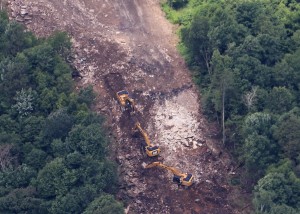From an Article by Mike Soraghan, E&E News, August 15, 2019
Federal regulators have found unsafe construction practices at work sites on the Atlantic Coast pipeline, spelling more trouble for a project that’s already facing setbacks in court.
Inspectors in December found crews laying pipe in ditches lined with rocks, which make the line more vulnerable to damage or stresses as a result of movement or settlement.
The inspection took place in Doddridge and Lewis counties in West Virginia, about 100 miles northeast of Charleston, according to the warning letter sent late last month to Dominion Energy Inc., the lead company on the pipeline.
The Pipeline and Hazardous Materials Safety Administration (PHMSA) decided against seeking a fine, according to the letter from Robert Burrough, director of PHMSA’s Eastern Region.
Dominion officials said in a statement the inspection occurred during a halt in construction ordered by the 4th U.S. Circuit Court of Appeals, and the company was under orders to act only minimally in the area.
After the Federal Energy Regulatory Commission authorized a stabilization plan, the company fixed the problems, according to the statement. It added that those details will be included in the response the company intends to send to PHMSA.
“We are committed to meeting the highest standards for quality, safety and environmental protection throughout this construction and we are proud of the job we’re doing,” Dominion said.
Construction on the 600-mile natural gas pipeline is on hold, bedeviled by legal problems that have pushed the project cost beyond $7.5 billion. It is to run from West Virginia through Virginia and into eastern North Carolina.
The 4th Circuit decision that the Forest Service improperly authorized the pipeline to cross the Appalachian Trail could stop the project in its tracks if the high court doesn’t take the developers’ case and rule in their favor.
During the December inspection, a 42-inch pipe was found to have been laid in a “rock-laden” ditch, which can cause problems when the pipeline shifts underground. It was also reported to have been laid in an “excessively narrow” trench.
At another location, pipe was laid on top of rocks, the line hadn’t been centered in the ditch, and it was touching “rock-laden” trench walls. The warning letter said the site was near large unsupported boulders that could damage the pipeline from above as the ground settles.
“The identified conditions also have the potential to be exacerbated in the event of heavy rains and/or washouts,” the warning letter said. Heavy rains, erosions and landslides have been a significant problem for pipelines and pipeline construction in recent years.


{ 1 comment… read it below or add one }
Question: If we inspect 10% of a project and half of that is not up to safety standard, does that mean that 5% is bad or that 50% is bad.
Well constructed pipelines are health and safety risks which we are forced to live with.
We should not be forced to live with compromised safety, especially considering the size of recent explosions.
Bob Peckman